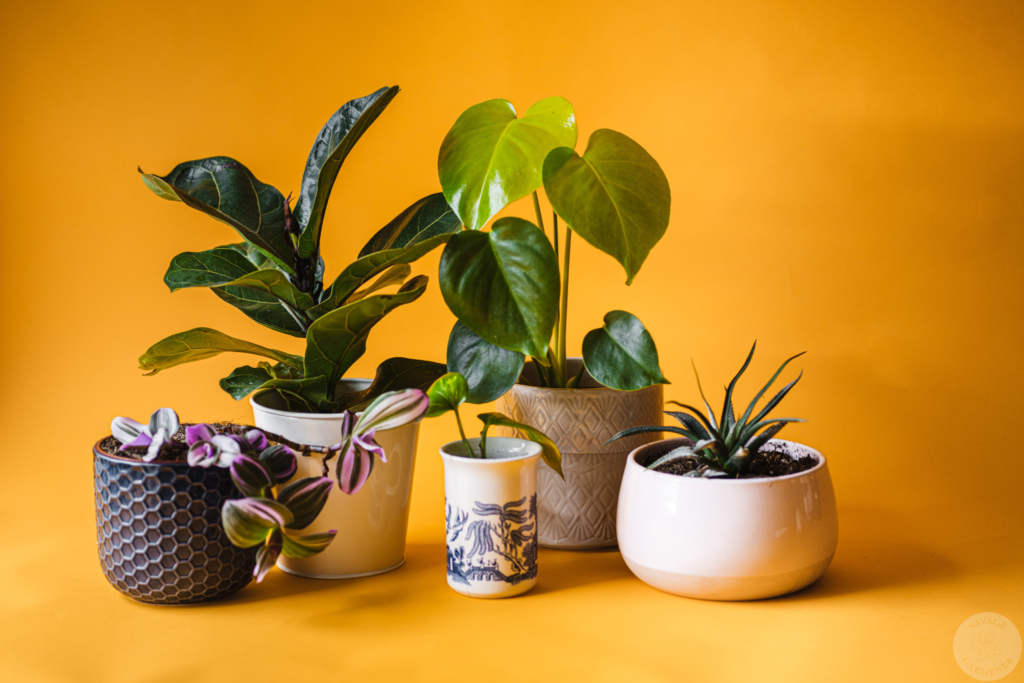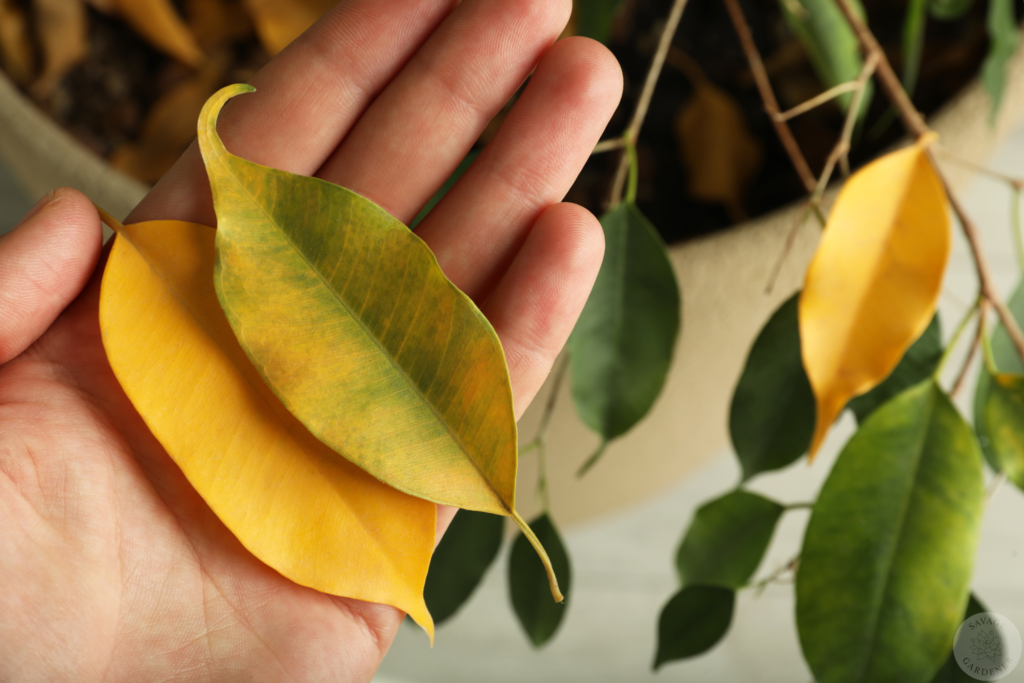
Are You Noticing Yellow Leaves on Your Plants?
Have you ever walked past your plants and suddenly spotted a yellow leaf staring back at you? I get it—it’s a little unsettling. You care for your plants, provide them water, light, maybe even a bit of fertilizer here and there. Then out of nowhere, a leaf starts to turn yellow! This happened to me recently with my Alocasia Frydek, due to the changing seasons in Canada. My Alocasia has been adjusting to lower light levels, which can sometimes trigger yellow leaves as they adapt. It’s a reminder that plant care isn’t always straightforward and that yellowing leaves often have something to tell us.
If you’re dealing with yellow leaves on your plants, there’s no need to panic. Yellow leaves are common among indoor plants and can mean a variety of things. Often, it’s an indicator of stress—whether it’s a bit too much water, too little light, or maybe a lack of nutrients. The good news? Many causes of yellowing leaves are fixable with a few adjustments. Instead of seeing a yellow leaf as a sign of failure, think of it as a nudge to understand your plant a little better. Plants communicate through their leaves, and with a bit of guidance, we can decode what they need.
In this guide, I’ll break down the most common causes of yellow leaves and share solutions to help bring your plants back to their healthiest, greenest selves. There are many different things which can cause this, so it is important to know which one is affecting your plant!
The Many Reasons for Yellow Leaves
Yellow leaves can be caused by several different factors, and getting to the root of the issue may take a bit of detective work (haha, the root). Some of the most common reasons include overwatering, underwatering, lighting issues, and nutrient deficiencies, but there’s more! Each of these factors affects plants differently, but the signs they leave behind can help us diagnose what’s going on.
In the sections that follow, I’ll go into detail on each of these causes of yellow leaves. By the end, you’ll have a better idea of what’s causing your plants’ yellow leaves, and how to fix it! With a bit of observation and care, those yellow leaves can become a thing of the past.
Overwatering: The Most Common Culprit
While we’re talking about it, let’s start with the root! One of the most common reasons for yellowing leaves is overwatering. If you’re like many plant owners, it’s easy to accidentally overwater, thinking it’s keeping your plant healthy and happy. But in reality, overwatering can do more harm than good. When soil is constantly wet, it deprives plant roots of the oxygen they need. This lack of oxygen causes the roots to weaken, and the first sign of trouble often appears in the form of—you guessed it—yellow leaves.
Signs of overwatering include leaves that are soft, drooping, and sometimes even mushy. The soil will likely be wet or soggy to the touch, and you may notice the lower leaves on your plant turning yellow first. If this sounds familiar, it might be time to cut back on your watering routine. A good rule of thumb is to let the top inch or so of soil dry out between waterings. You can check this by simply sticking your finger into the soil or using a moisture meter if you want to be extra precise.
Improving drainage can also help prevent yellow leaves from overwatering. Make sure your plant is in a pot with drainage holes, allowing excess water to escape. You might also want to consider adding a layer of small stones or pebbles at the bottom of the pot. Adjusting your watering schedule can take a little practice, but it’s a valuable step in becoming a confident, attentive plant parent.
Underwatering: A Close Second
On the other end of the spectrum, underwatering can also cause yellow leaves. When plants don’t receive enough water, they can’t perform the essential functions that keep them healthy. This stress shows up as yellowing leaves, often with dry, crispy edges. It’s almost as if the leaves are saying, “Hey, I’m thirsty over here!” When plants consistently lack water, their leaves start to dry out, curl, and eventually turn yellow. These are all signs of the plant trying to conserve moisture.
The first thing you’ll want to do if you suspect underwatering is to check the soil. If the soil is dry throughout or even pulling away from the sides of the pot… it’s a clear sign that your plant is overdue for water! Be careful not to just pour water over the dry soil. This can often lead to water pooling at the surface rather than soaking down to the roots. Instead, water thoroughly until the excess starts draining out of the bottom.
If you do notice the soil pulling away from the sides, I’ve seen others call this the “ring of death”. Simple watering and waiting for the water to come out the bottom may not be enough. This is because the water has a fast track there! Letting a plant with the “ring of death” soak for a few hours saturates the soil and sets everything right!
Indoor climates, especially in winter, can be quite dry, which only adds to the likelihood of underwatering. Plants may need a bit more water during these times. Developing a consistent watering schedule and checking soil moisture regularly can go a long way in preventing yellow leaves from underwatering.
Lack of Light: A Key Factor in Leaf Health
Another key factor in keeping plant leaves green is light. Without sufficient light, plants can’t produce enough chlorophyll—the pigment that gives leaves their green colour. Low light leads to chlorophyll breakdown, resulting in yellow leaves. I’ve noticed this, particularly in my lower-light plants during the darker winter months when the natural sunlight we get here in Canada just isn’t as strong.
Signs that your plant may be lacking light include yellowing leaves that seem to stretch or lean toward the light source, often accompanied by leggy or thin growth. To fix this, try moving your plant closer to a natural light source, like a bright window. If that’s not possible, consider using a grow light to give it the boost it needs.
A little light adjustment can make a big difference in keeping leaves green and vibrant. Remember, each plant has unique lighting needs. Understanding your plant’s preferences can help you avoid those yellow leaves from poor lighting conditions.

Nutrient Deficiencies: Plants Need Their Vitamins Too
Just like us, plants need a balanced diet to stay healthy, and without certain essential nutrients, they can develop yellow leaves. Nutrient deficiencies, especially in nitrogen, iron, and magnesium, are common culprits. For example, a lack of nitrogen often causes older leaves to turn yellow, while younger leaves may stay green.
Recognizing nutrient deficiencies can be tricky since different deficiencies show up in different ways. You may notice a pattern of yellowing that starts on older leaves or shows up as pale green or yellowish veins. This means it may be time to consider adding a bit of fertilizer to your plant’s diet. There are many balanced fertilizers available for houseplants, so look for one that’s suitable for your specific plant type. I enjoy using Plant RX fertilizer – which I get from House of Plants.
Think of fertilizer as a multivitamin for your plant, supporting overall growth and resilience. Keeping your plant’s nutrients balanced will help it maintain vibrant, healthy foliage and reduce the chance of yellow leaves due to deficiencies.
Temperature Stress: Keeping It Cozy
Just like people, plants have comfort zones when it comes to temperature. When they’re exposed to conditions outside these zones, it can lead to yellow leaves. Plants will get yellowing leaves when they face drastic temperature swings or sit near a drafty window or heating vent. This is often called ‘temperature stress’.
This is especially common in colder climates, like here in Canada! Windowsills can become chilly in winter and heating systems can dry out air. Leaving plants vulnerable to both hot and cold extremes! Moving plants away from windows can be tough in winter, as this also lowers their lights! I make sure my leaves are at least 4 inches away from the window. This distance is not perfect, but it seems to do the job!
Signs of temperature stress usually show up as sudden yellowing, often on leaves nearest to the cold or hot source. Plants positioned too close to radiators might experience leaf yellowing from heat stress, while those near drafty doors or windows can suffer from the cold, leading to a similar reaction. For tropical plants like Monstera or Fiddle Leaf Figs, stable, moderate temperatures are ideal, typically between 65°F and 75°F (18°C to 24°C).
To help avoid temperature stress, try placing your plants in a draft-free location away from heaters or air conditioners. Indoor plants, especially those with sensitive leaves, will also appreciate a humidifier during the winter months to help counteract dry air. Pay attention to how your home’s heating and cooling affect your plants throughout the year. A simple adjustment to their location can go a long way in preventing yellow leaves caused by temperature stress and creating a cozy environment where they can thrive year-round.
Pest Infestations: Tiny Insects Lead to Yellow Leaves
One of the trickier causes of yellow leaves to diagnose is pest infestations. Tiny pests like spider mites, aphids, mealybugs, and scale insects can be hard to spot at first, but their presence can sap the nutrients and moisture from your plants, leading to leaf discoloration, especially yellowing. These pests feed on the juices within leaves and stems, depriving your plant of essential nutrients and leaving behind damaged, yellowing foliage. Left unchecked, they can quickly multiply and cause further distress.
Signs of pest infestations can include sticky residue on the leaves, small holes, or even webbing around the affected area (particularly with spider mites). Often, the undersides of leaves are the most common hiding spots for these tiny intruders, so it’s a good habit to inspect them regularly. If you suspect pests are the reason behind your plant’s yellow leaves, act swiftly. Start by isolating the affected plant from others to prevent the pests from spreading. Then, gently wash the leaves with water and apply insecticidal soap or neem oil, which are effective yet gentle solutions.
Consistency is key with pest treatment—repeating the application every few days for a couple of weeks will ensure you catch any new pests that may emerge. While pests can be a frustrating part of plant care, dealing with them quickly and effectively can prevent major damage and help your plant recover its health and vibrant green leaves.
Natural Aging: When Yellow leaves are Normal
Not every yellow leaf is a sign of trouble; in fact, some yellowing is completely natural. As plants grow, older leaves often turn yellow and fall off, especially those at the base of the plant. This is part of a plant’s life cycle, where energy is directed towards producing new growth rather than sustaining older, less productive leaves. Think of it as your plant’s way of letting go of what it no longer needs!
This natural aging process typically affects the lower leaves first, and the yellowing happens gradually rather than suddenly. Unlike other causes of yellow leaves, where an entire section or random patches might be affected, natural aging usually limits itself to a few leaves here and there, while the rest of the plant remains vibrant and healthy.
To distinguish natural aging from other issues, observe whether your plant is still putting out new growth. If it is and only a few older leaves are yellowing, you likely have nothing to worry about. Embrace this normal cycle and feel free to gently prune away the yellow leaves to tidy up your plant’s appearance. Natural aging is a healthy sign of growth and renewal, a reminder that plants, like us, evolve over time.
Key Takeaways for Healthier, Happier Plants
By now, you’ve explored several possible reasons behind yellow leaves and learned some practical solutions to help your plants thrive. In summary, yellow leaves can stem from various causes, including overwatering, underwatering, lighting issues, nutrient deficiencies, temperature stress, pest infestations, and even the natural aging process. Each of these issues affects plants differently, but with careful observation and a bit of knowledge, you can tackle them head-on.
Remember, successful plant care is a journey. With a few simple adjustments—like balancing your watering routine, ensuring adequate lighting, checking for pests, and monitoring temperature—your plants can bounce back from yellowing and grow healthier than ever. Patience and a willingness to learn are essential, and every step brings you closer to mastering the art of plant care. Here’s to happier, greener plants and the joy they bring to your home!
Embracing Plant Care as a Learning Journey
Caring for plants is a journey full of little lessons. Yellow leaves, rather than being a sign of defeat, are opportunities to grow as a plant parent. No one has all the answers, and even seasoned plant lovers encounter challenges from time to time. Every yellow leaf invites you to slow down, observe, and respond to your plant’s needs with care and curiosity. Each time you investigate a yellowing leaf and take steps to understand the cause, you’re learning more about your plant and how to care for it better.
There’s a unique satisfaction in watching a plant you’ve nurtured thrive. Over time, you’ll develop a rhythm with your plants—a deeper awareness of their needs, their cycles, and the subtle ways they communicate. So embrace the journey and allow yourself to experiment, make adjustments, and continue learning. As you gain confidence, plant care becomes less about avoiding mistakes and more about cultivating a meaningful, rewarding relationship with the green friends in your space. Here’s to every leaf, yellow or green, that adds joy and life to our homes.
Do you need to learn how to help get your houseplants ready for winter? read Plant Light 101: How to Adjust for Seasonal Changes.
Discover more from Savage Gardener
Subscribe to get the latest posts sent to your email.



1 Comment
Dorothy
October 28, 2024 at 10:43 amI like your reference to the yellow leaf on your plant as it’s Hallowe’en costume!